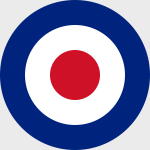Corgi AA38403 RAF Bristol Blenheim Mk. 1F Night Fighter - 54 OTU Squadron (Nightfighter Training Unit), Church Fenton, Summer 1941 (1:72 Scale)
"The essence of leadership . . . was, and is, that every leader from flight commander to group commander should know and fly his airplanes."
- Air Vice-Marshal J. E. 'Johnnie' Johnson, RAF
 Bristol Aeroplane's Blenheim was a British high-speed light bomber used extensively in the early days of the Second World War. It was later adapted into a successful heavy fighter. A Canadian-made variant named the Bolingbroke was used as an anti-Submarine and training aircraft. It was the first British aircraft to have all-metal stressed skin construction and one of the first to utilize retractable landing gear, flaps, powered gun turret and variable-pitch propellers.
Bristol Aeroplane's Blenheim was a British high-speed light bomber used extensively in the early days of the Second World War. It was later adapted into a successful heavy fighter. A Canadian-made variant named the Bolingbroke was used as an anti-Submarine and training aircraft. It was the first British aircraft to have all-metal stressed skin construction and one of the first to utilize retractable landing gear, flaps, powered gun turret and variable-pitch propellers.
The Type 135 civil twin design was on Bristol drawing boards by July 1933.
In 1934 Lord Rothermere, owner of the Daily Mail, issued a challenge to the British aviation industry to build a high-speed aircraft capable of carrying six passengers and two crew members. At the time German firms were producing a variety of high-speed designs that were breaking records, and Rothermere wanted to recapture the title of fastest civilian aircraft in Europe. Bristol had been working on a suitable design as the Type 135 since July 1933, and further adapted it to produce the Type 142 to meet Rothermere's requirements.
When it first flew as Britain First at Filton on April 12th, 1935, it proved to be faster than any fighter in service with the Royal Air Force at the time. The Air Ministry was obviously interested in such an aircraft, and quickly sent out Specification B.28/35 for prototypes of a bomber version of the Bristol called the Type 142M (M for "military"). The main changes were to move the wing higher on the fuselage from its former low position, to allow room under the spar for a bomb bay. The aircraft was all-metal with twin Bristol Mercury VIII radial engines of 860 hp (640 kW) each. It carried a crew of three -- pilot, navigator/bombardier and gunner/wireless operator - and was armed with a forward firing 0.303 inch (7.7 mm) machine gun outboard of the port engine and a 0.303 inch machine gun in a semi-retracting dorsal turret firing to the rear. A 1,000-lb (454 kg) bombload was carried in the internal bay.
To achieve its relatively high speed, the Blenheim had a very small fuselage. Pilot's quarters on the left side of the nose were so cramped that the control yoke obscured all flight instruments while engine instruments eliminated the forward view on landings. Most secondary instruments were arranged along the left side of the cockpit with essential items like propeller pitch control actually placed behind the pilot where they had to be operated by feel alone. Like most contemporary British aircraft, the bomb bay doors were kept closed with bungee cords and opened under the weight of the released bombs. Because there was no way to predict how long it would take for the bombs to force the doors open, bombing accuracy was rather mediocre.
Pictured here is a 1:72 scale replica of a RAF Bristol Blenheim Mk. 1F night fighter that was attached to 54 OTU Squadron.
Sold Out!
Dimensions:
Wingspan: 9-1/4-inches
Length: 7-1/4-inches
Release Date: June 2010
Historical Account: "When Darkness Falls" - Bristol Blenheim K7159 was originally built in 1936 as one of the first MkI bombers to come off the production line. It was then converted to fighter standard in late 1938 and equipped with AI (Airborne Interception) night fighting radar during the latter part of 1939.
Although the Blenheim was soon surpassed in the night-fighting role by more capable machines, its initial use proved the concept of using radar wave technology as an effective method of finding enemy aircraft attacking by night. This example is shown in the scheme and markings worn while serving with No. 54 OTU (Operational Training Unit) at Church Fenton, Yorkshire in 1941 after its withdrawal from front-line RAF service.





![German McDonnell F-4F Phantom II Fighter-Bomber - 37+03, Jagdgeschwader 71 "Richtofen", Germany, 2009 [Anniversary Scheme] (1:72 Scale)](http://cdn4.volusion.store/qh9e9-jdqv9/v/vspfiles/photos/HA19052-1.jpg?v-cache=1740197136)



